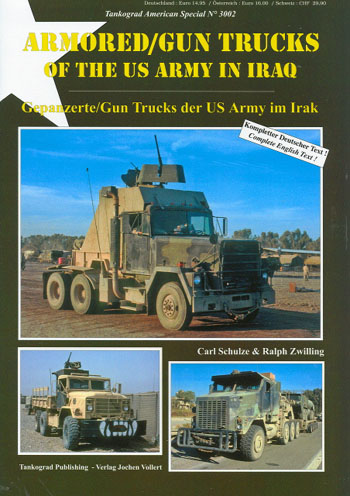Tankograd American Special No.
3002; Armored/Gun Trucks of the US Army in Iraq by Carl Schulze and Ralph
Zwilling
by Cookie Sewell

Verlag Jochen Vollert, Erlangen. Germany 2005; 64 pp.; price 14.95 Euros
(ISBN not present)
Advantages: great reference book on modern US Army operations in Iraq;
research appears well done and fairly complete
Disadvantages: modelers may be disappointed at lack of scale drawings
Rating: Highly Recommended
Recommendation: for all modern US fans as well as anybody who ever got
shot at in a "softskin" truck!
The invention of armor probably dates to the dawn of man, when one fellow
realized he needed protection from the rocks and sticks being thrown at
him by another fellow. This continued when man started using conveyances,
and it is likely that the first charioteers felt the same way - the higher
and thicker the protection, the better things are. But it was not until
the creation of "war wagons" in the middle ages people suddenly
felt you could fight back from behind protection, too.
Even when motorization took place in the 19th Century, it was not long
before protected trains followed in the American Civil War and the invention
of the first armored railway cars in South Africa in 1899 for the Boer
War. Likewise when gasoline engines replaced steam and tires replaced
rails, the same thinking followed. The champion of all time appears to
be an armored Guinness delivery truck in Ireland during the "Troubles"
but that is still a bit extreme.
During every other war that followed, soldiers figured out fast that
mobile warfare meant that "rear area" was a rather conditional
term, and that "softskin" – wood, steel, aluminum or later
fiberglass bodied – vehicles were sitting ducks to artillery or
in a fire fight.
While every major military vehicle since 1950 seems to have had armored
kits developed to provide them protection, few of them are usually used
for a number of reasons. The two main ones were the limitations on access
and visibility that they instill to their "host" vehicle and
the increased weight, which reduces payload and mobility. But the thought
of getting blown to bits is not one most soldiers hold dear, and thus
any measure that can be taken to reduce that chance is acceptable at the
troop level.
I can concur wholeheartedly, having found myself in that situation in
Vietnam in May 1970. I was driving an unarmored M35A1 truck when I accidently
nicked a Vietnamese on a Honda 50 and sent him flying into a puddle (we'll
ignore the fact he was passing on the right, I was turning right, and
the co-driver warned him off.) The enraged and soggy Vietnamese turned
out to be a "cowboy" – one of the local thugs with small
pistols and bad attitudes. He immediately went for what appeared to be
a .32 revolver and all that was between he and I was eight feet of space
and the sheet metal door of the Deuce. About the time I figured this is
not what was on my agenda for the day, I heard the sound of three M16
bolts locking up and a rather crude challenge from the cargo area to "just
try it." He departed the area in a hurry, soggy bike and all, but
it was about as close as I felt like coming to getting shot. (I got shot
at twice more later on, but this is a book review, not my adventures in
Vietnam.)
The same problems bothered the Soviets in Afghanistan, the various ethnic
groups in the former Yugoslavia, and now the American forces in Iraq.
And every time local troop units have had to create their own armor protection
until factory kits can be provided.
This neat new book from "Tankograd" provides a good, thorough
assessment of the efforts over the last two years as well as nearly 150
clear, sharp, color photos of a wide assortment of vehicles fitted with
both factory kits and the locally manufactured kind – now referred
to by the press as "Hillbilly Armor" protection. All of the
vehicles in this book started life as softskins and have now been protected
over the occupied areas of the vehicles to protect the crews from ambushes,
improvised explosive devices (IEDs – booby traps), and other close
combat weaponry.
The vehicles covered include light vehicles (mostly HUMMV types. 2 1⁄2
and 5 ton tactical cargo trucks. HEMTTs of all types, and the so-called
rear area types – from M915 "line haul" cargo carriers
to the massive M1070 HET tractor. Both the "Hillbilly" versions
and the factory kits are shown for most vehicles. Some Marine efforts
such as those involving their version of the HEMTT (The Mk 48, which differs
in that it articulates in the middle) as well as their heavy artillery
tractors.
Also included are a number of "gun trucks" similar to the convoy
escorts created and used in Vietnam by the US Army. But from what is shown
here, so far none of them have the panache of the Vietnam models such
as the legendary "Eve of Destruction" (now in the Transportation
Museum at Fort Eustis, Virginia) as they all are pretty drab or rusty.
The sole different one in the book is an M923A2 truck with two bumpers
welded together one on top of the other and a rather ferocious set of
white teeth added.
Overall, this book should answer most questions about how the troops
are trying to defeat the enemy's efforts and how the US Army has actually
responded to the problem, not the rather uninformed opinions presented
in the press.
Thanks to Peter Brown for the review sample.
Cookie Sewell
|